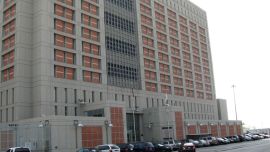Economy Minister Luis Caputo spent the better part of his first televised address explaining how Argentina got into such a dire economic situation: an “addiction” to debt, for which the only medicine is shock treatment.
“There is no more money,” Caputo said repeatedly in the recorded video published Tuesday night, echoing President Javier Milei’s words during his inaugural speech on Sunday.
The Wall Street veteran then outlined 10 initial measures designed to jolt the stagnant economy, starting with a massive 54 percent devaluation of the peso’s official exchange rate and austerity measures including halving the number of ministries, cutting transfers to provinces, suspending public works and reducing subsidies.
Total spending cuts will amount to 2.9 percent of gross domestic product, a senior government official said later. The goal is to eliminate the primary budget deficit, which doesn’t take into account interest payments, by the end of 2024.
The International Monetary Fund praised the government’s “bold initial actions” and many investors welcomed the measures as steps in the right direction. Yet many also remained sceptical, considering the moves either insufficient or hard to implement — or both.
“Are these measures good? Yes. Are they enough? It doesn’t seem so. Would they work? It really depends on people’s reactions,” said Diego Ferro, founder of M2M Capital in New York. “Let’s cross our fingers and hope that in the next two, three months people accept this and this works.”
Ferro’s reaction encapsulates the essence of Milei’s challenge. The libertarian leader needs to move fast because Argentina has run out of options to finance itself without resorting to the money-printing that has sent annual inflation soaring to more than 140 percent. But at the same time, he can’t easily jettison all the capital controls imposed over the years, as allowing the currency to float would risk triggering even faster inflation.
Gradual changes
For now, those controls remain in place, and the crawling peg regime will be overhauled to allow the peso to weaken two percent per month. Some social programmes will also receive a boost in a bid to ease the pain caused by austerity.
In a statement published overnight, the Central Bank maintained the benchmark Leliq rate at 133 percent while lowering the interest rate at one-day repo notes to 100 percent from 126 percent.
The Central Bank also said it would continue financing the government’s fiscal deficit while it seeks international credit options. It reiterated that Argentina will ask the IMF to waive upcoming debt repayments after the previous administration didn’t comply with targets agreed to with the Fund.
“The government will make the necessary efforts to re-establish the agreement signed with the IMF while carrying out additional negotiations to improve current financing conditions,” the Central Bank wrote in the statement.
Measures such as cutting transfers of funds to provinces could backfire, according to Adriana Dupita, an economist with Bloomberg Economics.
“Federal transfers to provinces are a relevant part of the budget, but simply cutting them doesn’t necessarily solve the fiscal problem,” Dupita said. “Unless provinces are able and willing to cut expenditures, this measure only transfers the deficit from federal to regional governments. It may also raise concerns on the outlook for provincial bonds.”
The announced measures don’t amount to an economic plan, according to Jorge Piedrahita, founder of Gear Capital Management in New York. “They leave a flavour of improvisation,” he said.
Unavoidable devaluation
The initial steps taken by Caputo follow a sombre inauguration speech on Sunday, when Milei warned that Argentines will have to endure months of pain while he works to pull the country from the economic crisis inherited from his predecessor.
The devaluation was long seen as inevitable, with investment banks such as JPMorgan Chase & Co and local private advisory firms suggesting the government could weaken the peso about 44 percent. Hours before the Tuesday announcement, grocers had already increased prices and banks were offering sharply weaker retail exchange rates.
The previous government had been burning reserves to keep the currency largely steady at 350 pesos per dollar since the August primary vote, when Milei’s surprise showing sent markets into a tailspin. In parallel markets, that rate is about 1,000.
Argentine authorities had for years tried to slow the peso’s decline in the official market through currency controls and import restrictions in an attempt to protect dwindling foreign currency reserves. That hodgepodge of measures has spawned at least a dozen different exchange rates, hampering business and investment in the economy.
On the campaign trail, Milei even pledged to scrap the currency altogether, replace it with the US dollar and shutter the Central Bank, but eventually put these plans on the back burner. Instead, he started prioritising a programme of fiscal adjustment.
After being spooked by his showing in the August primary, investors have since warmed to the firebrand libertarian, cheering on his first steps as president-elect — including his picks of Wall Street veterans for some of the main Cabinet positions. As he begins his four-year term, the rally will be put to the test.
Caputo previously served as finance chief in the administration of Mauricio Macri, when he negotiated a US$16.5-billion deal with holdout bondholders, allowing Argentina to return to international capital markets.
Caputo also tapped longtime colleague Santiago Bausili, a Deutsche Bank and JPMorgan Chase & Co veteran, to run Argentina’s Central Bank.
related news
by Manuela Tobias & Ignacio Olivera Doll, Bloomberg






















Comments